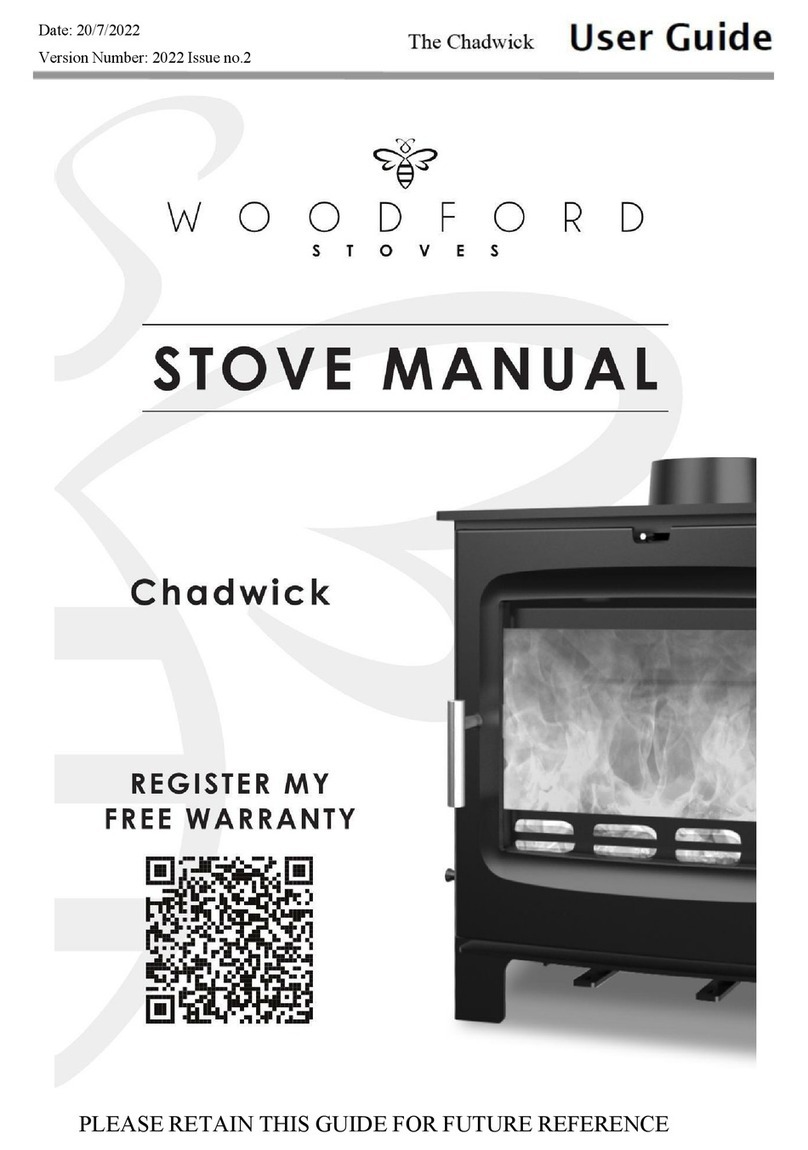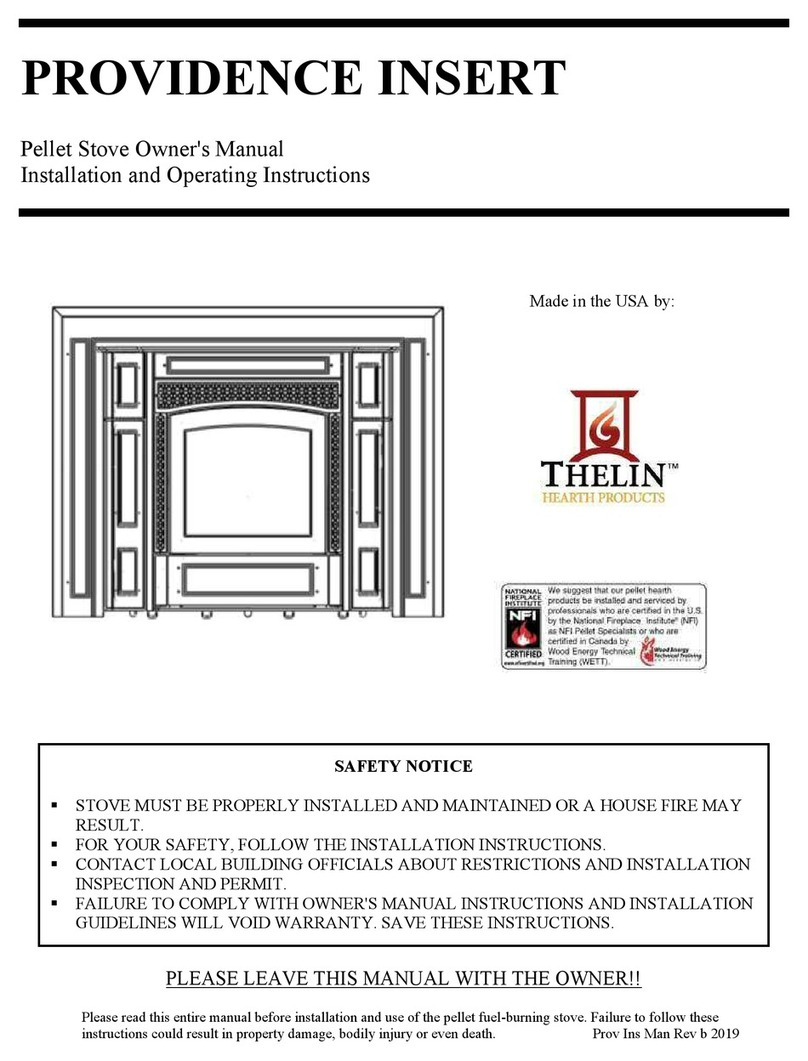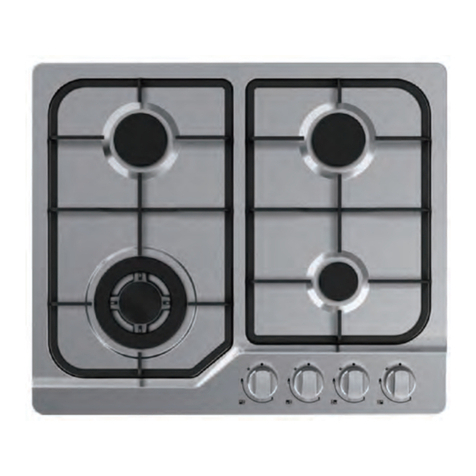Even Temp Element-MF User manual

Element-MF Installation and Operations Manual
Page 1
Installation & Operations Manual
Element-MF
Save these Instructions
61
5
Please read this entire manual before installation and use of this Multi-Fuel burning
room heater. Failure to follow these instructions could result in property damage,
bodily injury or even death."
Contact local building or fire officials about restrictions and installation inspection
requirements in your area.

Element-MF Installation and Operations Manual
Page 2
General Information ....................................................................................................................... 4
Installation Check List ............................................................................................................... 5, 6
Element-MF Layout Diagram..................................................................................................... 7, 8
Element-MF Dimension ................................................................................................................. 9
Approved Installations .....................................................................................................................9
Venting - Approved Materials .......................................................................................................10
Venting Size Guidelines.................................................................................................. 10
Venting-Typical PL Vent Components............................................................................11
Venting - Determining Materials ................................................................................... 12
Venting - Termination Requirements......................................................................... 13-14
Venting: Termination Clearance Requirements ............................................................. 15
Venting – Into an existing Chimney.................................................................................16
Venting – Hearth Mount...................................................................................................17
Floor Protection ........................................................................................................................... 18
Minimum Clearances ............................................................................................................. 19-20
Outside Combustion Air ............................................................................................................... 21
Mobile Home Installation ..............................................................................................................22
Element-MF Operation ...............................................................................................................23
Preventing Chimney Fires...........................................................................................................23
Approved Fuels...........................................................................................................................23
Corn, Wheat, Rye, Cherry Pits & Distiller’s Grain ............................................... 23-25
Installation Check .................................................................................................................25, 26
TABLE OF CONTENTS

Element-MF Installation and Operations Manual
Page 3
Control Board Features .........................................................................................................26, 27
Pre-Lighting Instructions ...................................................................................................... 27-28
Lighting Instructions...................................................................................................................29
Shutting Off the Insert ................................................................................................................30
Importance of Proper Draft.........................................................................................................30
Initial Damper Settings ................................................................................................30
Adjusting the Damper ............................................................................................31, 32
Flame Pattern Characteristics ......................................................................................32
Use of a Thermostat ............................................................................................................ 32, 34
Diagnostic Features & Safety Sensors.................................................................................. 34-36
Element-MF Maintenance .............................................................................................................37
Clinker/Ash Removal (Multi-Fuel pot) ..........................................................................37
Daily Maintenance (Multi-Fuel Pot)......................................................................... 37-40
Periodic Maintenance................................................................................................ 41-43
Yearly Maintenance ..................................................................................................43, 44
Safe Operation ...............................................................................................................................44
Wiring Schematic...........................................................................................................................45
Troubleshooting & Frequently Asked Questions ............................................................... 46-49
Parts Breakdown ...................................................................................................................... 50-57
Warranty ........................................................................................................................................58
Element-MF Info & Notes .............................................................................................................59

Element-MF Installation and Operations Manual
Page 4
GENERAL INFORMATION SAFETY PRECAUTIONS
SAFETY NOTICE: The ELEMENT-MF must be properly installed in order to prevent the
possibility of a house fire! These installation instructions must be strictly observed! The
Maintenance schedule must be followed as described in this manual. Failure to follow
instructions may result in property damage, bodily injury or even death.
The Element-MF’s exhaust system works with negative combustion chamber pressure and a
slightly positive chimney pressure. Therefore, it is imperative that the air intake and exhaust
system be airtight and installed correctly. Do not install a flue damper in the exhaust vent of this
unit.
Do not connect this unit to a chimney flue serving another appliance.
BUILDING PERMIT
Contact the local building officials to obtain a permit and information on any local installation
restrictions and inspection requirements.
DEFINITION OF “STOVE”
The word “Stove” as used in this manual to describe the Element-MF is interpreted to mean a
Multi-Fuel Stove approved for Corn, Wheat, Rye, Cherry Pits and Distiller’s Grain. This stove is
not intended as the sole source of heat.
EMISSIONS TESTING
The Element-MF is a “Non-Affected Facility” and was not tested to comply with U.S.
ENVIRONMENTAL PROTECTION AGENCY 2020 particulate emission standards using pellet
fuel.
The Element-P was certified to the 2020 Phase of ASTM E2779-2010. Heat Output: 8874
BTU/hr – 25406 BTU/hr, Efficiency: 64.7% using the higher Heat Value of the Fuel. Emission
Rate .660 gr/h
SAFETY TESTING
The Element-MF has been independently tested and listed by Warnock Hersey Laboratories in
accordance with the proposed ASTM E 1509-2004 Standards and the applicable portions of UL
1482 and ULC S627/B366.2, and Oregon Administrative Rules 814-23-901 through 814-23-
909, stating requirements for installation the Element-MF and for mobile home installations. The
safety-listing label is located on the top of the hopper. Please refer to label for pertinent
information.
DISCLAIMER OF WARRANTY
Since Even Temp Company has no control over the installation of the Element-MF, Even Temp
Company grants no warranty, implied or stated, for the installation of the Element-MF and
assumes no responsibility for any special, incidental or consequential damages.
MANUFACTURED FOR:
Even Temp Inc., Hwy 34, Waco, NE, 68467, Phone: 1-402-728-5255
Save This Installation & Operations Manual

Element-MF Installation and Operations Manual
Page 5
- FOR USE IN THE U.S. AND CANADA
- MOBILE HOME APPROVED
- CHECK WITH LOCAL AUTHORITIES AND OBTAIN NEEDED PERMITS. OBTAIN
FINAL INSPECTION FROM LOCAL BUILDING OFFICIALS.
- WE RECOMMEND INSTALLATION BY A QUALIFIED PROFESSIONAL OR
DEALER.
- ADHERE TO ALL CLEARANCES SPECIFIED BY THE MANUFACTURER OF THE
VENTING SYSTEM USED.
-
ADHERE TO ALL CLEARANCES SPECIFIED IN THE INSTALLATION
INSTRUCTIONS OF THIS STOVE.
- THIS STOVE USES A POSITIVE PRESSURE VENTING SYSTEM. DO NOT
INSTALL A FLUE DAMPER IN THE EXHAUST SYSTEM OF UNIT.
- DO NOT CONNECT THIS STOVE TO A CHIMNEY SYSTEM THAT IS
CONNECTED TO ANOTHER APPLIANCE.
- DO NOT INSTALL THIS UNIT IN A SLEEPING ROOM.
- INSTALL A SMOKE DETECTOR IN PROXIMITY OF THE STOVE.
- INSTALL A CARBON MONOXIDE DETECTOR IN PROXIMITY OF THE STOVE
ATTENTION
- CONDENSATION
:
When planning the installation of your Stove, keep in mind that
condensation is detrimental to exhaust systems. Install the Stove with a minimum of the
vent system exposed to the cold temperatures outside the envelope of the house.
- BATTERY BACKUP: St Croix does not offer battery backups. They are available online
if you decide to use one. Battery backup systems are useful if the Stove is installed using
horizontal venting only. This prevents any smoke from entering your home in the event of a
power failure.
- OPTIONAL EXHAUST FAN RELAY KIT: With optional relay kit 80P54232 installed in
the stove and connected to an inexpensive UPS battery backup (not part of the kit) you will
have maximum protection against smoke leaking out of the stove in the event of a power
failure. This is considered the best installation when venting horizontally. Contact your
dealer for more information.
1. All joints of PL vent and single wall stainless steel pipe should be fastened by at least 3
screws and correctly installed. (Follow vent manufacturer’s instructions). Seal all joints with
high temperature silicone to create an airtight seal.
INSTALLATION CHECK LIST

Element-MF Installation and Operations Manual
Page 6
2. A certain amount of carbon monoxide may be produced within the Stove as a by-product of
combustion. All exhaust vent connections must be sealed with RTV silicone to assure a gas tight
seal. Any leaks into a confined area caused by faulty installation or improper operation of
the Stove could produce dizziness, nausea and in extreme cases, death. The CO
concentration in the flue gas during the testing of the Element-P was 11.31 g/hr. The Element-
MF is a “Non-Affected Facility” and was not tested.
3. WARNING: The high temperature paint on this Stove may take several hours of burning at a
high fuel setting to cure fully. During this time, an odor that is not harmful may be evident.
When odors are present, the area around the Stove should be well ventilated.
4. Caution: The high temperature paint can be easily scratched prior to burning the Stove.
5. Have your dealer demonstrate all the operational and maintenance steps necessary for proper
use of the Stove. Sign and return the warranty card to the address listed on the back page.
6. Some odors may be given off during the first few hours of burning during initial break-in.
These odors are normal and not harmful. However, ventilating the room until the odors disappear
is recommended.
7. The Stove will become HOT while in operation. Keep clothing and furniture away from all hot
surfaces.
8. To avoid the possibility of smoke and/or sparks entering the room always keep firebox and ash
pan doors closed whenever the Stove is operating. Smoke detectors, installed in the same general
area as the Stove, may be activated if the Stove door is left open and smoke is allowed to enter
the area.
9. Under certain circumstances an outside source of combustion air may be needed and is
required on all mobile home installations. Use only approved parts. When using outside air for
combustion, check that the outside air inlet is connected to draw fresh air from outside the
building. If room air is used to supply combustion air, room air starvation (not enough make-up
air), operation of exhaust fans and icing of air vents can adversely affect proper Stove operation.
This Multi-Fuel heater has a manufacturer-set minimum low burn rate that must not be altered. It
is against federal regulations to alter this setting or otherwise operate this Multi-Fuel heater in a
manner inconsistent with operating instructions in this manual.
CAUTION: FAILURE TO FOLLOW THE INSTRUCTIONS IN THE INSTALLATIONS
MANUAL MAY RESULT IN A HOUSE FIRE, PROPERTY DAMAGE, BODILY
INJURY, OR EVEN DEATH. PLEASE FOLLOW INSTALLATION AND
MAINTENANCE INSTRUCTIONS.
CAUTION: NEVER ADD FIRE STARTER TO A HOT STOVE.
CAUTION - Hot Surfaces
- Keep Children away.
- Do not touch during Operation.

Element-MF Installation and Operations Manual
Page 7
Element-MF
Stove Layout
Figure 1
There are two burn systems used in Element Series of stoves. These systems are
interchangeable in the stove body. This Manual covers the ELEMENT-MF, which uses the
Multi-Fuel Burn System
The Multi-Fuel Burn System is the St. Croix Patented “Clinker Removal System”. This
burn pot allows the clinker to be removed without losing the fire in the pot. This eliminates
the need of having to re-light the after removing the clinker. This burn system does not have
Self-Ignition. It is approved for Corn, Wheat, Rye, Cherry Pits & Distillers Grain.

Element-MF Installation and Operations Manual
Page 8
Figure 2
The Multi-Fuel Burn System is approved for Corn, Wheat, Rye, Cherry Pits and Distillers
Grain. Wood pellets are no longer approved for use (except as starter pellets) in Element-
MF’s built after the 2015 NSPS.

Element-MF Installation and Operations Manual
Page 9
STOVE DIMENSIONS
Figure 3
A - Width of Stove E - Center of stove to center of exhaust
B – Height of Stove F - Center of exhaust from Base of Stove
C – Center of Air Intake from Base of Stove G – Front of Stove to Back of Stove
D - Center of Stove to Center of Air Intake H – Front of Stove to end of Exhaust Pipe
Approved Installations
The Element-MF is approved for CONVENTIONAL and MOBILE HOME installations as a
FREESTANDING stove. The stove may also be installed on the Hearth in front of a Fireplace
and vented through the chimney of the fireplace.

Element-MF Installation and Operations Manual
Page 10
VENTING: APPROVED MATERIALS
The Element-MF requires a venting system approved for pellet or corn venting by a certified
testing lab. Approved pellet or corn venting materials are: 1) PL vent, a double wall vent with a
stainless steel liner; and 2) Single wall rigid or flexible stainless steel pipe. PL Vent and Single
wall vent is available through manufacturers such as: ICC Pellet Vent, Energy Vent LTD, James
A. Ryder, Simpson Dura Vent and Selkirk Metalbestos and is carried by many local dealers. In
this manual approved venting will be referred to a “PL vent” or “Single wall vent”. All single
wall vent adaptors must be stainless steel.
NOTE: TYPE “B” GAS VENT MUST NOT BE USED IN THE INSTALLATION OF THIS MULTI-
FUEL STOVE.
Venting size Guidelines
Type of Installation: Size:______________
A. Less than 10’ horizontal: 3” Acceptable
B. 10’ to 12’ horizontal: 3” or 4” Acceptable
C. Over 12’ horizontal: 4” Required
Horizontal installation over 12’ is NOT RECOMMENDED
D. Less than 15’ vertical: 3” Acceptable
E. Over 15’ vertical: 4” Required
F. Above 4000’ elevation: 3” or 4” Acceptable
Note: Four (4) inch vent may be used in all installations. If in doubt, use 4” vent.
Examples of venting system components follow:
High temperature ceramic roping reduces potential fly ash escaping through joints.
Stainless steel inner liners resist corrosive flue gas damage to the system.
Flex pipe should be stainless steel, 4 ply construction with a total thickness of approximately .07
inches.

Element-MF Installation and Operations Manual
Page 11
TYPICAL PL VENT COMPONENTS
RAIN CAP
VERTICAL OR WALL THIMBLE CHIMNEY SUPPORT BRACKET
HORIZONTAL ADAPTER
ADJUSTABLE LENGTH SINGLE TEE SINGLE REDUCTION DOUBLE TEE
PIPE w/TEE CAP TEE w/TEE CAP w/TEE CAP
PIPE ADAPTER INCREASER 45
0
ELBOW 90
0
ELBOW

Element-MF Installation and Operations Manual
Page 12
VENTING: DETERMINING MATERIALS
TYPE OF MATERIALS:
1. PL Vent / Corn Vent must be used.
2. All Joints in the venting installation must be fastened together using three screws. All joints of
the venting system must be sealed with High Temp Silicone to make a gas tight fit.
3. Exception: Single wall stainless steel may be used inside an existing chimney. (No
clearances to combustibles are needed on single wall stainless steel adaptors, rigid or flex pipe
installed within a chimney.)
4. A clean-out “tee” (PL Vent or “Quick-Connect Exhaust”) must be installed directly to the
Stove and at the bottom of each vertical run of the exhaust system. These tees are to assist in
periodically cleaning the pipe. Single or double clean-out tees may be used. The exhaust system
must be installed so the entire system can be cleaned without disassembly.
NOTE: ADHERE TO THE PL VENT CLEARANCES TO COMBUSTIBLES AS REQUIRED.
STRICTLY OBSERVE THE PL VENT MANUFACTURER’S SAFETY SPECIFICATIONS.
QUANTITY OF MATERIALS:
1. It is recommended that the vent system be installed with a minimum of three feet (3’) of
vertical rise above the exhaust port on the back of the Element-MF.
FAILURE TO PROVIDE THE NATURAL DRAFT THAT RESULTS FROM A VERTICAL
RISE MAY RESULT IN SMOKE BEING RELEASED INTO THE HOUSE WHEN
ELECTRICITY TO THE UNIT IS INTERRUPTED WHILE BURNING OR SMOLDERING
FUEL REMAINS IN THE BURN GRATE. (See “Battery Backup” on page 5)
2. It is not recommended to run vertical venting outside the heated environment where the
Element-MF is installed. Running a venting system in a cold environment may cause the flue
temperatures to cool down too much for adequate drafting.
Additional vertical exhaust venting should be provided when using:
a. More than one (1) elbow or tee; and/or
b. Horizontal runs of over three (3) feet. (Horizontal runs over 10 feet not recommended)
3. For a venting system ending in a horizontal run, the exhaust pipe must be terminated by a
listed end cap or a PL vent elbow (45 or 90 degrees). Note: End caps or elbows must vent
exhaust gases away from the building.
4. For termination above the building roofline a rain cap is required.
5. The exhaust pipe on all Element-MF’s is 3” O.D. to accommodate a pipe adaptor.

Element-MF Installation and Operations Manual
Page 13
VENTING: TERMINATION REQUIREMENTS
In determining optimum vent termination, carefully evaluate external conditions especially when
venting directly through a wall. Since you must deal with odors, gases, and fly ash, consider
aesthetics, prevailing winds, distances from air inlets and combustibles, location of adjacent
structures and any code requirements.
1. Exhaust must terminate above combustion air inlet elevation.
2. Do not terminate vent in any enclosed or semi-enclosed area, (i.e. Carports, garage, attic
crawl space, etc.) or any location that can build up a concentration of fumes.
3. Vent surfaces can get hot enough to cause burns if touched by children. Non-combustible
shielding or guards may be required
The type of installation must first be considered before determining the exact location of
the venting termination in relationship to doors, window, cavities or air vents.
a. Without Outside Air connected to the unit. For this types of installation please refer to
the dimensions listed below in figure 4.
Figure 4
4’ (1.2 m) BELOW a door, window, cavity, or air vent
Or
4’ (1.2 m) HORIZONTALLY FROM a door, window, cavity, or air vent
Or
1’ (305 mm) ABOVE a door, window, cavity, or air vent

Element-MF Installation and Operations Manual
Page 14
b. With Outside Air Connected to the unit. In this manner the appliance is a Direct Vent
Appliance (sealed Combustion System) as listed in NFPA 211-6.
3.3.3.2 Direct Vent Appliance (Sealed Combustion System Appliance) A system
consisting of an appliance, combustion air and flue gas connections between the
appliance and the outside atmosphere, and a vent cap supplied by the manufacturer, and
constructed so that all the air for combustion is obtained from the outside atmosphere
and all flue gases are discharged to the outside atmosphere.
Special Venting Arrangements are listed in NFPA 211-31
10.7.1.2 The Vent Terminal of a Direct Vent Appliance with an input of 10000 BTU/Hr or
less shall be located at least 6” from any opening into a building, and such an appliance
with an input of over 10000 BTU/Hr, but not over 50000 BTU/Hr shall not be located
less than 9” from any opening through which vent gases could enter a building, and the
vent terminal of such appliance with an input over 50000 BTU/Hr shall be located not
less than 12” from the opening.
Figure 5
9” (229 mm) ABOVE, BELOW OR HORIZONTALLY FROM a door, window, cavity, or air
vent.

Element-MF Installation and Operations Manual
Page 15
VENTING: TERMINATION CLEARANCE REQUIREMENTS
Figure 6
THE EXHAUST TERMINATION LOCATION MUST BE AT LEAST
1’ (305 mm) ABOVE the ground level
7’ (2.1 m) FROM a public walkway
1’ (305 mm) FROM The wall penetration point
3’ (915mm) FROM a gas meter/regulator assembly
2’ (610 mm) FROM any adjacent combustibles such as:
Adjacent buildings, fences, protruding parts
of the structure, roof eaves or overhangs,
plants, shrubs, etc.

Element-MF Installation and Operations Stove
Page 16
VENTING: INTO AN EXISTING CHIMNEY
The stove may be connected to an existing Class A chimney or a masonry chimney which meets
the minimum requirements of NFPA 211.
1. If the stove’s exhaust is connected to a masonry chimney, the masonry chimney must be
free of cracks that could leak exhaust gases or fly ash. A relining of the chimney with either
PL vent or single wall stainless steel pipe may be necessary to bring the chimney into
compliance.
2. When chimneys are relined, a chimney chase cap that reduces the outlet of the chimney to
the size of the liner is required. Extend the exhaust vent above the chimney chase cap and
finish it off with a rain cap. A single wall liner may need to be insulated to maintain
adequate exhaust temperatures in the vent system Note: Outside Chimneys frequently
are difficult to keep warm, if in doubt insulate the liner.
Figure 7 Figure 8
Venting into Masonry Chimney Venting into a Class A Chimney
3. Venting into the side of an existing masonry chimney must be done through a masonry
thimble. When wall penetration is necessary to access a masonry chimney, use a listed PL
vent wall thimble. (Figure 7).
4. When venting into a Class A steel chimney, use an appropriate PL Vent adapter. (Figure 8)

Element-MF Installation and Operations Stove
Page 17
Hearth Mount
Legend
A – Vertical Cap
B – Chimney Flashing
C – Stainless Steel Liner / PL Vent System
D – Positive Block Off Plate
E – PL Tee or Single Wall Tee
F – Outside Air Shield – May be needed
G – 2” Metal Outside Air Pipe - Optional
Figure 9
Venting to the Top of Chimney
When installing as a hearth mount stove into a fireplace, the unit must either be relined
terminating above the chimney chase top, or positively connected to the existing chimney system
using a block off plate (C). An approved flex liner or PL vent must be used. A chimney system
with known drafting problems may require a liner, which may also need to be insulated to
keep vent system warm in a cold chimney environment.

Element-MF Installation and Operations Stove
Page 18
FLOOR PROTECTION
The stove must be installed on a Non-Combustible Surface.
Hearth models may be placed directly on the noncombustible hearth of a fireplace.
The Hearth / Non-Combustible pad must extend a minimum of 6” (152 mm) in Front of Unit and
beyond each side of the Fuel Loading and Ash Removal Opening(s).
Figure 10
Floor protection
(Top View)

Element-MF Installation and Operations Stove
Page 19
MINIMUM CLEARANCES (INCHES) TO COMBUSTIBLE MATERIAL
Figure(s): From:
12, 15 Sides of stove 4”
12, 15 Back of stove 4”
11 Corner of stove 4”
7, 8 Vent pipe Per Manufacturer’s Instructions
13 Stove to mantel 12”
10 Floor protection: Front (from faceplate) 6”
10 Floor protection: Sides & back of stove 0”
14 Alcove: Vertical to Combustibles 16”
15 Alcove: Sides 4”
15 Alcove: Back 4”
Figure 11 (Top View) Figure 12 (Top View)
Clearances: corners of stove Clearances Sides and Back

Element-MF Installation and Operations Stove
Page 20
Floor Pad and Mantle Clearances Alcove Installation (Side View)
Figure 13 Figure 14
Figure 15
Alcove Installation (Top View)
Although 4“ is the minimum
clearance to the sides of the stove,
this is not recommended due to
the need for access into the inside
of the stove for the maintenance,
as spelled out in the Operations
Manual. Please read the section
covering the Daily Maintenance,
Periodic Maintenance and Yearly
Maintenance in the Operations
Manual.
Table of contents
Popular Stove manuals by other brands

Kanuk
Kanuk Bank instruction manual

Termodinamik
Termodinamik Pellet Stove Hybrid 22 kW Installation and usage manual

Firewarm stoves
Firewarm stoves FIREWARM 4 Installation and operating instructions
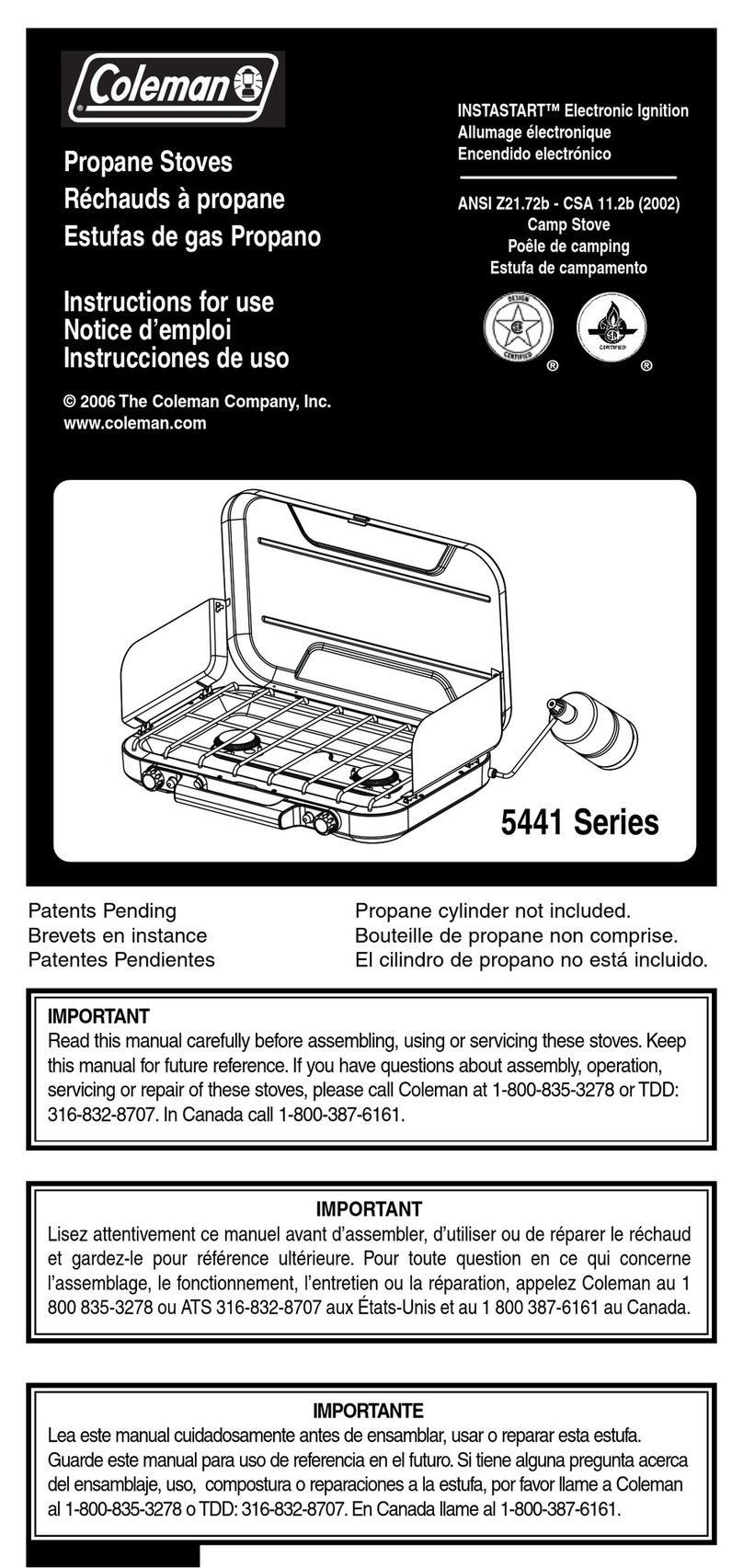
Coleman
Coleman 5441 Series Instructions for use

hergom
hergom GLANCE Installation, use and maintenance instructions
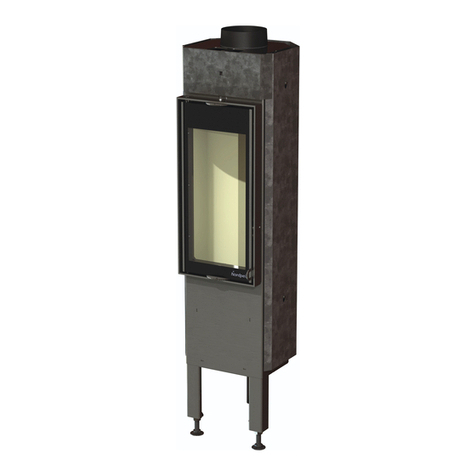
Nordpeis
Nordpeis X-20 F user manual

KEDDY
KEDDY K700 installation instructions

VARDE OVNE
VARDE OVNE Samso Installation and user guide
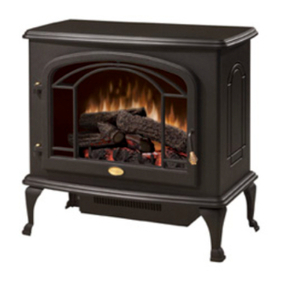
Dimplex
Dimplex DS7420 Service manual

EdilKamin
EdilKamin Alpen Installation, use and maintenance

Muskoka
Muskoka LEGION PANORAMIC EST-425T-10 Use and care guide

Cadel
Cadel Martina Installation, use and maintenance handbook


